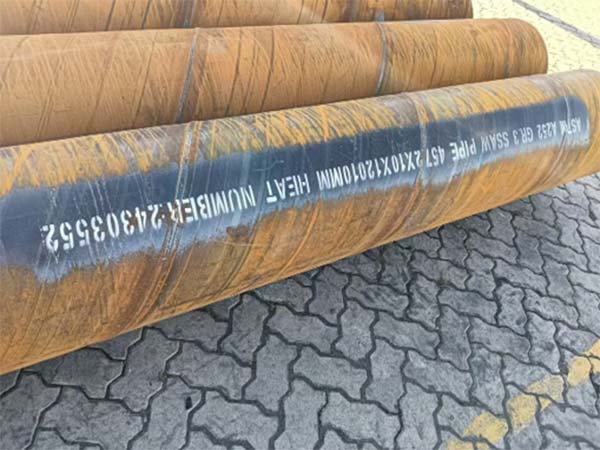SSAW pipe piles are large-diameter steel pipes made by spirally welding hot-rolled steel strips, and are widely used in bridge foundations, port terminals, offshore platforms and deep foundation pit support and other projects.
With advantages such as a wide diameter range, high strength and superior cost performance, SSAW pipe piles have become the mainstream choice in the modern infrastructure field. This article will provide a detailed introduction to the complete manufacturing process of SSAW pipe piles, from raw materials to the final product, helping you gain a comprehensive understanding of its production technology.

1. Selection and processing of raw materials
The manufacturing of SSAW pipe piles starts with high-quality hot-rolled steel coils, and common materials include carbon steel or low alloy structural steel.
Before production, steel coils need to undergo strict chemical composition and mechanical property tests to ensure that their strength and toughness meet the standard requirements.
Subsequently, Edge Milling is carried out on the edge of the steel plate to ensure that the edge of the welding area is flat, providing an ideal contact surface for the subsequent welding.
2. Spiral forming process
After uncoiling, the steel strip enters the forming machine and is continuously bent into the shape of a round pipe according to the set Helix Angle. The size of the helix Angle determines the diameter and wall thickness of the pipe body.
This spiral forming method can achieve continuous production, not only improving efficiency but also flexibly adjusting the size according to engineering requirements. It is highly suitable for large-diameter and long-length pile foundation projects.
3. Double-sided submerged arc welding both inside and outside
The formed steel pipes are welded by the inner and outer double-sided submerged arc welding (SAW) process.
During submerged arc welding, the welding arc is protected by a layer of slag, effectively preventing oxidation and improving the purity of the weld seam.
Modern production lines adopt automatic welding equipment to ensure uniform weld seams, thorough penetration and high strength. Double-sided welding not only enhances the compressive strength of the pipe body but also improves the safety and reliability of the overall structure.
4. Sizing and straightening
After the welding is completed, the pipe body enters the Sizing Mill for shape correction.
The function of this step is to ensure the roundness, straightness and dimensional accuracy of the pipe pile, and to eliminate the residual stress generated during the welding and forming process.
Good sizing quality can effectively prevent deviation or bending during the pile driving process in construction.
5. Quality inspection and non-destructive testing
Each SSAW pipe pile must undergo strict inspection before leaving the factory, including:
Ultrasonic testing (UT) : Check for cracks or slag inclusions inside.
Radiographic testing (RT) : To inspect the internal quality of weld seams;
Hydrostatic Test: Check the sealing performance by applying internal pressure.
Through these non-destructive testing (NDT) methods, it is ensured that each pipe pile meets the design requirements and international standards.
6. Pipe end processing and coating protection
After passing the inspection, the pipe ends will undergo Beveling to facilitate on-site welding construction.
Depending on the different usage environments, the pipe body can be coated with anti-corrosion layers such as Epoxy coating (Epoxy), 3LPE, and Bitumen asphalt paint (Bitumen) to enhance durability in seawater, soil or chemical media.
These anti-corrosion treatments are particularly important for offshore and coastal pile foundation projects.
7. Inspection and packaging
Before leaving the factory, the factory will conduct final size inspection, mark printing and packaging.
Each SSAW pipe pile is marked with information such as specifications, materials, standard numbers and furnace numbers to ensure traceability.
Pipe piles are usually packaged for export by means of binding, film wrapping or end cover protection, etc., to prevent damage during transportation.
Main applications and standards
SSAW pipe piles are widely used in:
Port and wharf engineering
Bridges and elevated foundations
Offshore wind power and platform foundation
Deep foundation pits and retaining structures
Common SSAW pipe pile standards include: API 5L, ASTM A252, EN 10219, JIS A5525, etc.
Summary
Through strict process control and inspection procedures, SSAW pipe piles perform outstandingly in terms of strength, stability and economy.
It is not only a key material for modern infrastructure construction, but also represents an efficient, safe and reliable engineering choice.
Read more : What is a piling pipe?
